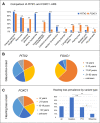Axenfeld-Rieger syndrome: more than meets the eye
- PMID: 35882526
- PMCID: PMC9912354
- DOI: 10.1136/jmg-2022-108646
Axenfeld-Rieger syndrome: more than meets the eye
Abstract
Background: Axenfeld-Rieger syndrome (ARS) is characterised by typical anterior segment anomalies, with or without systemic features. The discovery of causative genes identified ARS subtypes with distinct phenotypes, but our understanding is incomplete, complicated by the rarity of the condition.
Methods: Genetic and phenotypic characterisation of the largest reported ARS cohort through comprehensive genetic and clinical data analyses.
Results: 128 individuals with causative variants in PITX2 or FOXC1, including 81 new cases, were investigated. Ocular anomalies showed significant overlap but with broader variability and earlier onset of glaucoma for FOXC1-related ARS. Systemic anomalies were seen in all individuals with PITX2-related ARS and the majority of those with FOXC1-related ARS. PITX2-related ARS demonstrated typical umbilical anomalies and dental microdontia/hypodontia/oligodontia, along with a novel high rate of Meckel diverticulum. FOXC1-related ARS exhibited characteristic hearing loss and congenital heart defects as well as previously unrecognised phenotypes of dental enamel hypoplasia and/or crowding, a range of skeletal and joint anomalies, hypotonia/early delay and feeding disorders with structural oesophageal anomalies in some. Brain imaging revealed highly penetrant white matter hyperintensities, colpocephaly/ventriculomegaly and frequent arachnoid cysts. The expanded phenotype of FOXC1-related ARS identified here was found to fully overlap features of De Hauwere syndrome. The results were used to generate gene-specific management plans for the two types of ARS.
Conclusion: Since clinical features of ARS vary significantly based on the affected gene, it is critical that families are provided with a gene-specific diagnosis, PITX2-related ARS or FOXC1-related ARS. De Hauwere syndrome is proposed to be a FOXC1opathy.
Keywords: congenital, hereditary, and neonatal diseases and abnormalities; eye diseases; genetics; genetics, medical.
© Author(s) (or their employer(s)) 2023. Re-use permitted under CC BY-NC. No commercial re-use. See rights and permissions. Published by BMJ.
Conflict of interest statement
Competing interests: BW and GR are employees of GeneDx, Inc.
Figures




References
-
- Axenfeld T. Embryotoxon corneae posterius. Ber Deutsch Ophthalmol Ges 1920;42:301–2.
-
- Rieger H. Verlagerung und Schlitzform der Pupille mit Hypoplasie des Irisvorderblattes. Z Augenheilkd 1934;84:98–103.
Publication types
MeSH terms
Substances
Supplementary concepts
Grants and funding
LinkOut - more resources
Full Text Sources
